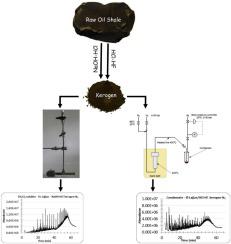Journal of Analytical and Applied Pyrolysis ( IF 6 ) Pub Date : 2021-01-21 , DOI: 10.1016/j.jaap.2021.105023 Jameel S. Aljariri Alhesan , Mohammad W. Amer , Marc Marshall , W. Roy Jackson , Yi Fei , Martin L. Gorbaty , Peter J. Cassidy , Alan L. Chaffee

|
The inherent reactivity of kerogens isolated from marine oil shales has not been extensively studied. Determining the conversion and products of demineralized oil shales simplifies modelling of oil shale pyrolysis because the complications introduced by the mineral matter are removed. Accordingly, the reactive behaviour of demineralized products (kerogens) isolated from two marine oil shales (type II kerogen) by NaOH-HCl and HCl-HF methods have been compared with each other and with those of untreated shales. Pyrolysis experiments have been carried out under N2 and H2 in a sealed system, and also in a flow through autoclave system, which is closer to practical pyrolysis conditions, at temperatures in the range 355 °C to 425 °C. The two isolation methods gave a similar conversion in sealed autoclaves and the only major difference was the higher asphaltol yield for the NaOH-HCl kerogens, so that asphaltol yield cannot be used to characterize the intrinsic reactivity of the shale organic matter. The El-Lajjun shale gave higher conversion to organic materials than the kerogens but the opposite was noted for Julia Creek, especially for pyrolysis under N2.
Pyrolysis experiments in a flow through system gave similar overall conversion for the kerogens and their untreated shales but the yields of condensates for the Julia Creek shale were significantly lower for the oil shales than for the kerogens. The chemical complexity of the condensates from the flow through experiments was much greater than that for the CH2Cl2 soluble samples from the sealed autoclave pyrolysis experiments.
The product compositions for the NaOH-HCl and HCl-HF kerogens were, as for the total yields, very similar, suggesting that the NaOH-HCl method is a valuable alternative in countries where the use of HF is severely restricted. Further, determining the reactive behaviour of kerogens isolated by two different methods makes it likely that features of the reactivity common to both types of kerogens are features of organic matter reactivity rather than of the isolation method and thus provides a firm foundation for future work. The isolated kerogen could also be considered as a source material for the production of fine chemicals and other applications.
中文翻译:

NaOH-HCl法和HCl-HF法从油页岩中分离出的海洋干酪根的热转化行为比较
从海洋油页岩中分离出的干酪根的固有反应性尚未得到广泛研究。确定脱盐油页岩的转化率和产物可以简化油页岩热解的建模,因为消除了矿物物质带来的复杂性。因此,已将通过NaOH-HCl和HCl-HF方法从两种船用油页岩(II型干酪根)中分离出的脱盐产品(干酪根)的反应性能与未经处理的页岩进行了比较。在N 2和H 2下进行了热解实验在355°C至425°C的温度范围内,在密闭系统中以及在更接近于实际热解条件的流通高压釜系统中也是如此。两种分离方法在密封高压釜中的转化率相似,唯一的主要区别是NaOH-HCl干酪根的沥青质产率更高,因此沥青质产率不能用于表征页岩有机质的固有反应性。El-Lajjun页岩向有机物的转化率比干酪根高,但朱莉亚·克里克(Julia Creek)的情况则相反,尤其是在氮2下的热解。
在流通系统中进行热解实验,得出干酪根及其未经处理的页岩的总转化率相似,但油页岩的Julia Creek页岩凝析油收率明显低于干酪根。通过实验的冷凝液的化学复杂性比密封高压釜热解实验的CH 2 Cl 2可溶样品的化学复杂性大得多。
就总产量而言,NaOH-HCl和HCl-HF干酪根的产品组成非常相似,这表明在严格限制使用HF的国家中,NaOH-HCl方法是一种有价值的替代方法。此外,确定通过两种不同方法分离的干酪根的反应行为,使得两种类型的干酪根共有的反应性特征很可能是有机物反应性的特征,而不是分离方法的特征,因此为将来的工作提供了坚实的基础。分离出的干酪根也可被视为生产精细化学品和其他应用的原料。


























 京公网安备 11010802027423号
京公网安备 11010802027423号